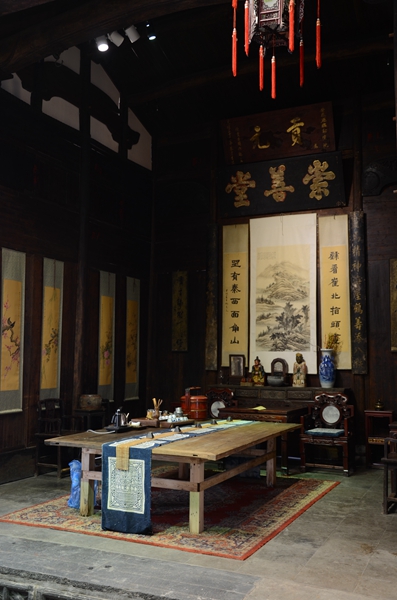Re-creating ancient history
Updated: 2016-06-10 07:33
By Zhu Lixin and Ma Chenguang(China Daily)
|
|||||||||
 |
|
Chong Shan Tang House is another ancient house restored by the team. Photo Provided To China Daily |
The old Huizhou homes, which in ancient times were mostly owned by merchants, were known for their exquisite wood, brick and stone carvings. The images carved on the components could vary widely from house to house, according to Xuan.
Xuan added that about 70 percent of the details of a Huizhou ancient house depended on the owner, instead of the craftsman. "Together, we make an ancient building restoration team, but none of us individually can be called a professional hand for such complex work."
Xuan pays each of the craftsmen 300 yuan ($45.60) per working day, but he never urges them to hurry up, since "for cultural relics restoration, haste makes waste", he said.
Xuan often brings Li and his colleagues to such places as Huangshan, which was known as a part of the Huizhou region, in order to give them more profound knowledge of Huizhou-style ancient residences.
Xuan, 58, started to collect components of ancient Huizhou buildings in 1981 and then began to buy whole houses in the next decade. "I was often shocked by people's ignorance of cultural relics", said the museum head, who worked as a salesman in a State-owned enterprise in the 1980s and then started his own company in the following decade.
The Huizhou region has been known throughout China partly for the success of its merchants in the Ming Dynasty (1368-1644) and Qing Dynasty (1644-1911). Many villages in the ancient Huizhou region are filled with ancient houses, some of which are being torn down to make way for more modern homes.
Xuan also remembers how he bought a masterpiece house in 2003. When he was traveling in the region, he saw people arguing about how to remove a two-story house, built in the early Qing Dynasty and called Chong Shan Tang House, and how to divide the wood and land. "Five impoverished families became occupants of the 260-square-meter house in the 1940s and passed it on to their descendants, who showed no respect for the property," Xuan said.
When Xuan saw the house, it was in critical condition and no longer suitable for habitation. He succeeded in buying the house from the arguing people. He decided to dismantle the house and bring it to Hefei and build a museum for it.
"In the 1980s and 1990s, there were also businessmen who bought the old houses. Some of them kept only the wooden pillars and beams, while the other components were considered useless," Xuan said.
He has seized the opportunity to buy many components used for restoring homes, such as doors and windows, since the 1980s. He started to build his museum in 2007 and opened it to the public in 2009.
Contact the writers at zhulixin@chinadaily.com.cn
Related Stories
Building a future for ancient neighborhoods 2016-06-10 02:54
Pottery relics reveal China's ancient stargazers 2016-05-31 11:09
Ancient book 'provides ironclad proof of Chinese ownership' 2016-05-24 02:16
Divers find ancient Roman cargo from 1,600-yr old shipwreck in Israel 2016-05-17 14:08
Palace Museum confirms ancient relics find 2016-05-06 08:06
Today's Top News
The can-do generation to the fore
Riding the wave
China lists first sovereign offshore RMB bond on LSE
British PM denounces Brexit's 'complete untruths'
47% of European businesses would expand in China
Xi urges Washington to boost trust
Council of Europe unveils security convention
Former PM warns of chaos in case of Brexit
Hot Topics
Lunar probe , China growth forecasts, Emission rules get tougher, China seen through 'colored lens', International board,
Editor's Picks

|

|

|

|

|

|







